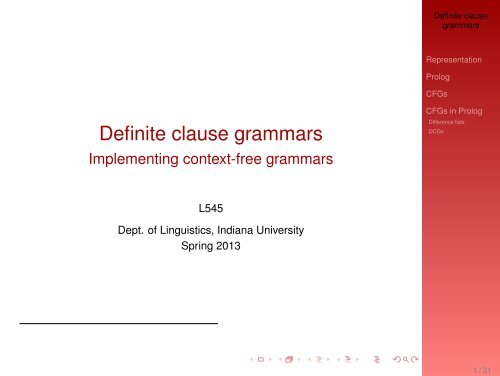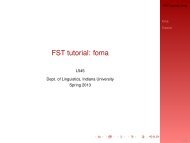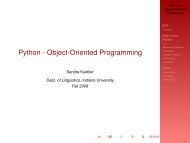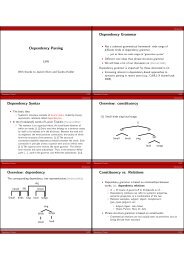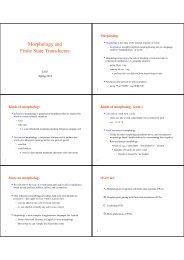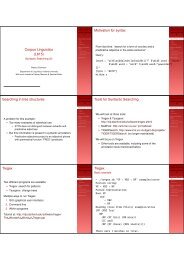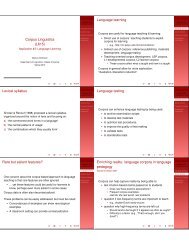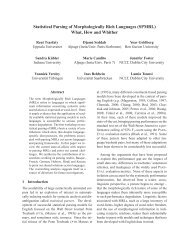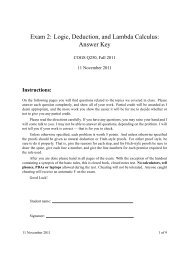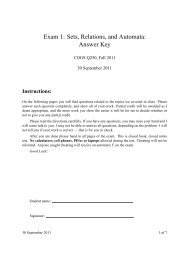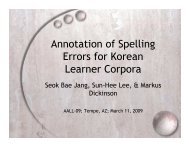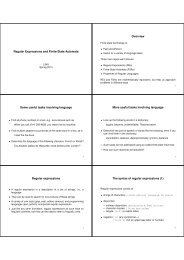Definite clause grammars - Implementing ... - Indiana University
Definite clause grammars - Implementing ... - Indiana University
Definite clause grammars - Implementing ... - Indiana University
Create successful ePaper yourself
Turn your PDF publications into a flip-book with our unique Google optimized e-Paper software.
1 / 31<br />
<strong>Definite</strong> <strong>clause</strong><br />
<strong>grammars</strong><br />
Representation<br />
Prolog<br />
CFGs<br />
<strong>Definite</strong> <strong>clause</strong> <strong>grammars</strong><br />
<strong>Implementing</strong> context-free <strong>grammars</strong><br />
CFGs in Prolog<br />
Difference lists<br />
DCGs<br />
L545<br />
Dept. of Linguistics, <strong>Indiana</strong> <strong>University</strong><br />
Spring 2013
2 / 31<br />
Representing context-free <strong>grammars</strong><br />
<strong>Definite</strong> <strong>clause</strong><br />
<strong>grammars</strong><br />
Representation<br />
◮ Towards a basic setup:<br />
◮ What needs to be represented?<br />
◮ Logic programming: Prolog<br />
◮ On the relationship between context-free rules and<br />
logical implications<br />
◮ A first Prolog encoding<br />
◮ Encoding the string coverage of a node:<br />
From lists to difference lists<br />
◮ Adding syntactic sugar:<br />
<strong>Definite</strong> <strong>clause</strong> <strong>grammars</strong> (DCGs)<br />
◮ Representing simple English <strong>grammars</strong> as DCGs<br />
Prolog<br />
CFGs<br />
CFGs in Prolog<br />
Difference lists<br />
DCGs
3 / 31<br />
What needs to be represented?<br />
<strong>Definite</strong> <strong>clause</strong><br />
<strong>grammars</strong><br />
Representation<br />
Prolog<br />
We need representations (data types) for:<br />
− terminals, i.e., words<br />
− syntactic rules<br />
− linguistic properties of terminals and their<br />
propagation in rules:<br />
− syntactic category<br />
− other properties<br />
− string covered (“phonology”)<br />
− case, agreement, . . .<br />
− analysis trees, i.e., syntactic structures<br />
CFGs<br />
CFGs in Prolog<br />
Difference lists<br />
DCGs
4 / 31<br />
Logic programming: Prolog<br />
<strong>Definite</strong> <strong>clause</strong><br />
<strong>grammars</strong><br />
Representation<br />
Prolog<br />
CFGs<br />
Logic programming languages are based upon<br />
mathematical logic.<br />
◮ Expressions used in the language are declarative<br />
◮ Expressions are then proven by a<br />
(backwards-reasoning) theorem-prover<br />
◮ If A, then B is seen as: to solve B, show A<br />
CFGs in Prolog<br />
Difference lists<br />
DCGs<br />
Prolog is one such logic programming language
5 / 31<br />
Expressions in Prolog<br />
<strong>Definite</strong> <strong>clause</strong><br />
<strong>grammars</strong><br />
Representation<br />
Prolog<br />
Prolog has two main expressions:<br />
◮ facts state that something is true, e.g.,<br />
green(house)<br />
◮ rules state implications:<br />
colored(X) :-<br />
green(X).<br />
This states that an item X is colored only if it is<br />
green. (Or: if X is green, it is colored.)<br />
CFGs<br />
CFGs in Prolog<br />
Difference lists<br />
DCGs
6 / 31<br />
SWI-Prolog<br />
<strong>Definite</strong> <strong>clause</strong><br />
<strong>grammars</strong><br />
Representation<br />
We will use the freely-available SWI-Prolog<br />
◮ http://www.swi-prolog.org<br />
Notes:<br />
◮ To open prolog, type swipl at a terminal<br />
◮ Databases of facts and predicates are stored in files<br />
ending in .pl (e.g., examples.pl)<br />
◮ To load a database, use brackets, followed by a full<br />
stop:<br />
?- [examples].<br />
% examples compiled 0.00 sec, 7 <strong>clause</strong>s<br />
true.<br />
Prolog<br />
CFGs<br />
CFGs in Prolog<br />
Difference lists<br />
DCGs
7 / 31<br />
Querying the database<br />
<strong>Definite</strong> <strong>clause</strong><br />
<strong>grammars</strong><br />
Representation<br />
Prolog<br />
You can query the database of facts and rules to see if<br />
something is true.<br />
◮ You can ask if something is true:<br />
?- green(house).<br />
Yes.<br />
◮ Or you can ask which things are green:<br />
?- green(X).<br />
X = house<br />
CFGs<br />
CFGs in Prolog<br />
Difference lists<br />
DCGs
8 / 31<br />
Querying different arguments<br />
<strong>Definite</strong> <strong>clause</strong><br />
<strong>grammars</strong><br />
If we have:<br />
height(house,20).<br />
Then we can query for either the height of house or<br />
items which have height 20<br />
Representation<br />
Prolog<br />
CFGs<br />
CFGs in Prolog<br />
Difference lists<br />
DCGs<br />
?- height(house,X).<br />
X = 20<br />
?- height(X,20).<br />
X = house<br />
?- height(car,X).<br />
no
9 / 31<br />
Evaluation<br />
<strong>Definite</strong> <strong>clause</strong><br />
<strong>grammars</strong><br />
Representation<br />
Prolog<br />
Multiple facts<br />
paint(house,green).<br />
paint(car,green).<br />
CFGs<br />
CFGs in Prolog<br />
Difference lists<br />
DCGs<br />
If I query paint(X,green), Prolog can return 2<br />
answers for X.<br />
◮ For the 2-argument predicate paint (sometimes<br />
written paint/2), there is a choice point.
10 / 31<br />
First-argument indexing<br />
<strong>Definite</strong> <strong>clause</strong><br />
<strong>grammars</strong><br />
Prolog actually works by indexing on its first argument<br />
paint(house,green).<br />
paint(car,blue).<br />
Representation<br />
Prolog<br />
CFGs<br />
CFGs in Prolog<br />
Difference lists<br />
DCGs<br />
It makes a difference as to which argument is not a<br />
variable (uninstantiated):<br />
◮ paint(house,X) — Prolog immediately knows that<br />
house only has predicate<br />
◮ paint(X,green) — Prolog doesn’t realize that<br />
there is only one matching predicate until it has<br />
checked all of them.<br />
Lesson: put the most informative item first
11 / 31<br />
Evaluating rules<br />
<strong>Definite</strong> <strong>clause</strong><br />
<strong>grammars</strong><br />
Representation<br />
Prolog<br />
Prolog does the same evaluation when rules<br />
(implications) are uses<br />
CFGs<br />
CFGs in Prolog<br />
Difference lists<br />
DCGs<br />
sibling(X,Y) :- parent(Z,X), parent(Z,Y).<br />
parent(john,susan).<br />
parent(john,polly).<br />
sibling(susan,polly) is true because<br />
parent(Z,susan) and parent(Z,polly) are true<br />
when Z = john
12 / 31<br />
Recursion<br />
<strong>Definite</strong> <strong>clause</strong><br />
<strong>grammars</strong><br />
Representation<br />
Evaluations in Prolog involve proving statements by<br />
recursing through rules<br />
parent(john,paul).<br />
parent(paul,tom).<br />
parent(tom,mary).<br />
ancestor(X,Y):- parent(X,Y).<br />
ancestor(X,Y):- parent(X,Z),<br />
ancestor(Z,Y).<br />
Prolog<br />
CFGs<br />
CFGs in Prolog<br />
Difference lists<br />
DCGs<br />
The query ancestor(john,tom) involves a recursive<br />
search through different rules.<br />
http://www.doc.gold.ac.uk/ ∼ mas02gw/prolog tutorial/prologpages/recursion.html
13 / 31<br />
Recursion (2)<br />
<strong>Definite</strong> <strong>clause</strong><br />
<strong>grammars</strong><br />
Representation<br />
Prolog<br />
What happens when we query ancestor(john,tom)?<br />
◮ Prolog checks the first definition of ancestor/2 and<br />
fails since there is no predicate parent(john,tom)<br />
◮ Prolog goes back to the choice point and checks the<br />
second definition:<br />
◮ With X = john, the only thing that will work is<br />
Z = paul (first argument indexing)<br />
◮ Prolog checks to see whether<br />
ancestor(paul,tom) is true.<br />
CFGs<br />
CFGs in Prolog<br />
Difference lists<br />
DCGs
14 / 31<br />
Lists<br />
<strong>Definite</strong> <strong>clause</strong><br />
<strong>grammars</strong><br />
Representation<br />
Prolog<br />
CFGs<br />
Prolog has a list data structure, represented by [ ... ]<br />
◮ [] = the empty list<br />
◮ [A] = [A|[]]<br />
◮ [A,B] = [A|[B]] = [A|[B|[]]]<br />
CFGs in Prolog<br />
Difference lists<br />
DCGs
15 / 31<br />
Looping<br />
<strong>Definite</strong> <strong>clause</strong><br />
<strong>grammars</strong><br />
Representation<br />
Lists & recursive predicates result in looping:<br />
my_length([],0).<br />
% _ is a variable we never use again<br />
my_length([_|T], N) :-<br />
my_length(T,M),<br />
N is M + 1.<br />
Prolog<br />
CFGs<br />
CFGs in Prolog<br />
Difference lists<br />
DCGs<br />
Example of querying:<br />
?- my_length([a,b,c],N).<br />
N = 3.
16 / 31<br />
Append<br />
<strong>Definite</strong> <strong>clause</strong><br />
<strong>grammars</strong><br />
Representation<br />
We need a way to join, or append, two lists together<br />
Prolog has such a built-in predicate, append/3, which<br />
can take lists L1 and L2, and return the joined list L3.<br />
Prolog<br />
CFGs<br />
CFGs in Prolog<br />
Difference lists<br />
DCGs<br />
append([],L2,L2).<br />
append([H1|T1], L2, [H1|L3]) :-<br />
append(T1,L2,L3).<br />
Example call:<br />
?- append([a,b,c],[d,e,f],X).<br />
X = [a, b, c, d, e, f].
17 / 31<br />
On the relationship between context-free<br />
rules and logical implications<br />
<strong>Definite</strong> <strong>clause</strong><br />
<strong>grammars</strong><br />
Representation<br />
Prolog<br />
◮ Take the following context-free rewrite rule:<br />
S → NP VP<br />
◮ Nonterminals in such a rule can be understood as<br />
predicates holding of the lists of terminals dominated<br />
by the nonterminal.<br />
◮ A context-free rules then corresponds to a logical<br />
implication:<br />
∀X∀Y ∀Z NP(X) ∧ VP(Y ) ∧ append(X,Y ,Z ) ⇒ S(Z )<br />
where X, Y , & Z refer to string yields<br />
◮ Context-free rules can thus directly be encoded as<br />
logic programs.<br />
CFGs<br />
CFGs in Prolog<br />
Difference lists<br />
DCGs
18 / 31<br />
Components of a direct Prolog encoding<br />
<strong>Definite</strong> <strong>clause</strong><br />
<strong>grammars</strong><br />
Representation<br />
Prolog<br />
◮ terminals: unit <strong>clause</strong>s (facts)<br />
◮ syntactic rules: non-unit <strong>clause</strong>s (rules)<br />
◮ linguistic properties:<br />
◮ syntactic category: predicate name<br />
◮<br />
other properties: predicate’s arguments,<br />
distinguished by position<br />
CFGs<br />
CFGs in Prolog<br />
Difference lists<br />
DCGs<br />
◮<br />
◮<br />
◮<br />
in general: compound terms<br />
for strings: list representation<br />
analysis trees:<br />
compound term as predicate argument
19 / 31<br />
A small example grammar G = (N, Σ, S, P)<br />
<strong>Definite</strong> <strong>clause</strong><br />
<strong>grammars</strong><br />
N = {S, NP, VP, V i , V t , V s }<br />
Σ = {a, clown, Mary, laughs, loves, thinks}<br />
S = S⎧<br />
S → NP VP<br />
⎪⎨<br />
P =<br />
⎪⎩<br />
VP → V i<br />
VP → V t NP<br />
VP → V s S<br />
V i → laughs<br />
V t → loves<br />
V s → thinks<br />
NP → Det N<br />
NP → PN<br />
PN → Mary<br />
Det → a<br />
N → clown<br />
⎫<br />
⎪⎬<br />
⎪⎭<br />
Representation<br />
Prolog<br />
CFGs<br />
CFGs in Prolog<br />
Difference lists<br />
DCGs
20 / 31<br />
An encoding in Prolog<br />
<strong>Definite</strong> <strong>clause</strong><br />
<strong>grammars</strong><br />
Representation<br />
Prolog<br />
s(S) :- np(NP), vp(VP), append(NP,VP,S).<br />
vp(VP) :- vi(VP).<br />
vp(VP) :- vt(VT), np(NP), append(VT,NP,VP).<br />
vp(VP) :- vs(VS), s(S), append(VS,S,VP).<br />
CFGs<br />
CFGs in Prolog<br />
Difference lists<br />
DCGs<br />
np(NP) :- pn(NP).<br />
np(NP) :- det(Det), n(N), append(Det,N,NP).<br />
pn([mary]). n([clown]). det([a]).<br />
vi([laughs]). vt([loves]). vs([thinks]).
21 / 31<br />
Difference list encoding<br />
<strong>Definite</strong> <strong>clause</strong><br />
<strong>grammars</strong><br />
Representation<br />
Prolog<br />
s(X0,Xn) :- np(X0,X1), vp(X1,Xn).<br />
vp(X0,Xn) :- vi(X0,Xn).<br />
vp(X0,Xn) :- vt(X0,X1), np(X1,Xn).<br />
vp(X0,Xn) :- vs(X0,X1), s(X1,Xn).<br />
CFGs<br />
CFGs in Prolog<br />
Difference lists<br />
DCGs<br />
np(X0,Xn) :- pn(X0,Xn).<br />
np(X0,Xn) :- det(X0,X1), n(X1,Xn).<br />
pn([mary|X],X). n([clown|X],X). det([a|X],X).<br />
vi([laughs|X],X). vt([loves|X],X). vs([thinks|X],X).
22 / 31<br />
Recognizing a sentence<br />
<strong>Definite</strong> <strong>clause</strong><br />
<strong>grammars</strong><br />
What happens with s([mary,laughs],[])?<br />
◮ Prolog responds with yes because the following<br />
predicates are true:<br />
Representation<br />
Prolog<br />
CFGs<br />
CFGs in Prolog<br />
Difference lists<br />
s([mary,laughs],[]) :-<br />
np([mary,laughs],[laughs]), vp([laughs],[]).<br />
DCGs<br />
vp([laughs],[]) :- vi([laughs],[]).<br />
np([mary,laughs],[laughs]) :-<br />
pn([mary,laughs],[laughs]).<br />
pn([mary|[laughs]],[laughs]).<br />
vi([laughs|[]],[]).
23 / 31<br />
Definitie <strong>clause</strong> <strong>grammars</strong> (DCG)<br />
Basic DCG notation for encoding CFGs<br />
<strong>Definite</strong> <strong>clause</strong><br />
<strong>grammars</strong><br />
Representation<br />
Prolog<br />
Prolog has a special notation for CFGs<br />
A definite <strong>clause</strong> grammar (DCG) rule has the form<br />
LHS --> RHS.<br />
◮ LHS: a Prolog atom encoding a non-terminal, and<br />
◮ RHS: a comma separated sequence of<br />
◮ Prolog atoms encoding non-terminals<br />
◮ Prolog lists encoding terminals<br />
CFGs<br />
CFGs in Prolog<br />
Difference lists<br />
DCGs<br />
When a DCG rule is read in by Prolog, it is expanded by<br />
adding the difference list arguments to each predicate.
24 / 31<br />
Examples for some cfg rules in DCG notation<br />
<strong>Definite</strong> <strong>clause</strong><br />
<strong>grammars</strong><br />
Representation<br />
Prolog<br />
◮ S → NP VP<br />
s --> np, vp.<br />
◮ S → NP thinks S<br />
s --> np, [thinks], s.<br />
◮ S → NP picks up NP<br />
s --> np, [picks, up], np.<br />
◮ S → NP picks NP up<br />
s --> np, [picks], np, [up].<br />
◮ NP → ɛ<br />
np --> [].<br />
CFGs<br />
CFGs in Prolog<br />
Difference lists<br />
DCGs
25 / 31<br />
An example grammar in definite <strong>clause</strong><br />
notation<br />
<strong>Definite</strong> <strong>clause</strong><br />
<strong>grammars</strong><br />
Representation<br />
Prolog<br />
s --> np, vp.<br />
np --> pn.<br />
np --> det, n.<br />
CFGs<br />
CFGs in Prolog<br />
Difference lists<br />
DCGs<br />
vp --> vi.<br />
vp --> vt, np.<br />
vp --> vs, s.<br />
pn --> [mary]. n --> [clown].<br />
det --> [a]. vi --> [laughs].<br />
vt --> [loves]. vs --> [thinks].
26 / 31<br />
The example expanded by Prolog<br />
<strong>Definite</strong> <strong>clause</strong><br />
<strong>grammars</strong><br />
?- listing.<br />
vt([loves|A], A).<br />
vs([thinks|A], A).<br />
pn([mary|A], A).<br />
det([a|A], A).<br />
n([clown|A], A).<br />
s(A, C) :-<br />
np(A, B),<br />
vp(B, C).<br />
np(A, B) :-<br />
pn(A, B).<br />
np(A, C) :-<br />
det(A, B),<br />
n(B, C).<br />
vp(A, B) :-<br />
vi(A, B).<br />
vp(A, C) :-<br />
vt(A, B),<br />
np(B, C).<br />
vp(A, C) :-<br />
vs(A, B),<br />
s(B, C).<br />
vi([laughs|A], A).<br />
Representation<br />
Prolog<br />
CFGs<br />
CFGs in Prolog<br />
Difference lists<br />
DCGs
27 / 31<br />
More complex terms in DCGs<br />
<strong>Definite</strong> <strong>clause</strong><br />
<strong>grammars</strong><br />
Non-terminals can be any Prolog term, e.g.:<br />
s --> np(Per,Num),<br />
vp(Per,Num).<br />
This is translated by Prolog to<br />
Representation<br />
Prolog<br />
CFGs<br />
CFGs in Prolog<br />
Difference lists<br />
DCGs<br />
s(A, B) :-<br />
np(C, D, A, E),<br />
vp(C, D, E, B).<br />
Restriction:<br />
◮ The LHS has to be a non-variable, single term<br />
(plus possibly a sequence of terminals).
28 / 31<br />
Using compound terms to store an analysis<br />
tree<br />
s(s_node(NP,VP)) --> np(NP), vp(VP).<br />
np(np_node(PN)) --> pn(PN).<br />
np(np_node(Det,N)) --> det(Det), n(N).<br />
<strong>Definite</strong> <strong>clause</strong><br />
<strong>grammars</strong><br />
Representation<br />
Prolog<br />
CFGs<br />
CFGs in Prolog<br />
Difference lists<br />
DCGs<br />
vp(vp_node(VI)) --> vi(VI).<br />
vp(vp_node(VT,NP)) --> vt(VT), np(NP).<br />
vp(vp_node(VS,S)) --> vs(VS), s(S).<br />
pn(mary_node) --> [mary].<br />
n(clown_node) --> [clown].<br />
det(a_node) --> [a].<br />
vi(laugh_node)--> [laughs].<br />
vt(love_node) --> [loves].<br />
vs(think_node)--> [thinks].
29 / 31<br />
Example call<br />
<strong>Definite</strong> <strong>clause</strong><br />
<strong>grammars</strong><br />
Representation<br />
Prolog<br />
CFGs<br />
CFGs in Prolog<br />
Difference lists<br />
DCGs<br />
?- s(Tree,[mary,laughs],[]).<br />
Tree = s_node(np_node(mary_node), vp_node(laugh_node))
30 / 31<br />
Adding more linguistic properties<br />
<strong>Definite</strong> <strong>clause</strong><br />
<strong>grammars</strong><br />
s --> np(Per,Num), vp(Per,Num).<br />
vp(Per,Num) --> vi(Per,Num).<br />
vp(Per,Num) --> vt(Per,Num), np(_,_).<br />
vp(Per,Num) --> vs(Per,Num), s.<br />
Representation<br />
Prolog<br />
CFGs<br />
CFGs in Prolog<br />
Difference lists<br />
DCGs<br />
np(3,sg) --> pn.<br />
np(3,Num) --> det(Num), n(Num).<br />
pn --> [mary].<br />
det(sg) --> [a]. n(sg) --> [clown].<br />
det(_) --> [the]. n(pl) --> [clowns].<br />
vi(3,sg) --> [laughs].<br />
vt(3,sg) --> [loves].<br />
vs(3,sg) --> [thinks].<br />
vi(_,pl) --> [laugh].<br />
vt(_,pl) --> [love].<br />
vs(_,pl) --> [think].
31 / 31<br />
Tracing agreement properties<br />
<strong>Definite</strong> <strong>clause</strong><br />
<strong>grammars</strong><br />
?- trace.<br />
true.<br />
Representation<br />
Prolog<br />
CFGs<br />
CFGs in Prolog<br />
Difference lists<br />
[trace] ?- s([mary,laugh],[]).<br />
DCGs<br />
Call: (6) s([mary, laugh], []) ? creep<br />
Call: (7) np(_G631, _G632, [mary, laugh], _G634) ? creep<br />
Call: (8) pn([mary, laugh], _G632) ? creep<br />
Exit: (8) pn([mary, laugh], [laugh]) ? creep<br />
Exit: (7) np(3, sg, [mary, laugh], [laugh]) ? creep<br />
Call: (7) vp(3, sg, [laugh], []) ? creep<br />
Call: (8) vi(3, sg, [laugh], []) ? creep<br />
Fail: (8) vi(3, sg, [laugh], []) ? creep<br />
Redo: (7) vp(3, sg, [laugh], []) ? creep<br />
Call: (8) vt(3, sg, [laugh], _G634) ? creep<br />
Fail: (8) vt(3, sg, [laugh], _G634) ? creep<br />
Redo: (7) vp(3, sg, [laugh], []) ? creep
32 / 31<br />
Tracing agreement properties (2)<br />
<strong>Definite</strong> <strong>clause</strong><br />
<strong>grammars</strong><br />
Representation<br />
Call: (8) vs(3, sg, [laugh], _G634) ? creep CFGs in Prolog<br />
Difference lists<br />
Fail: (8) vs(3, sg, [laugh], _G634) ? creep<br />
DCGs<br />
Fail: (7) vp(3, sg, [laugh], []) ? creep<br />
Redo: (7) np(_G631, _G632, [mary, laugh], _G634) ? creep<br />
Call: (8) det(_G631, [mary, laugh], _G633) ? creep<br />
Fail: (8) det(_G631, [mary, laugh], _G633) ? creep<br />
Fail: (7) np(_G631, _G632, [mary, laugh], _G634) ? creep<br />
Fail: (6) s([mary, laugh], []) ? creep<br />
false.<br />
?- notrace.<br />
Prolog<br />
CFGs


